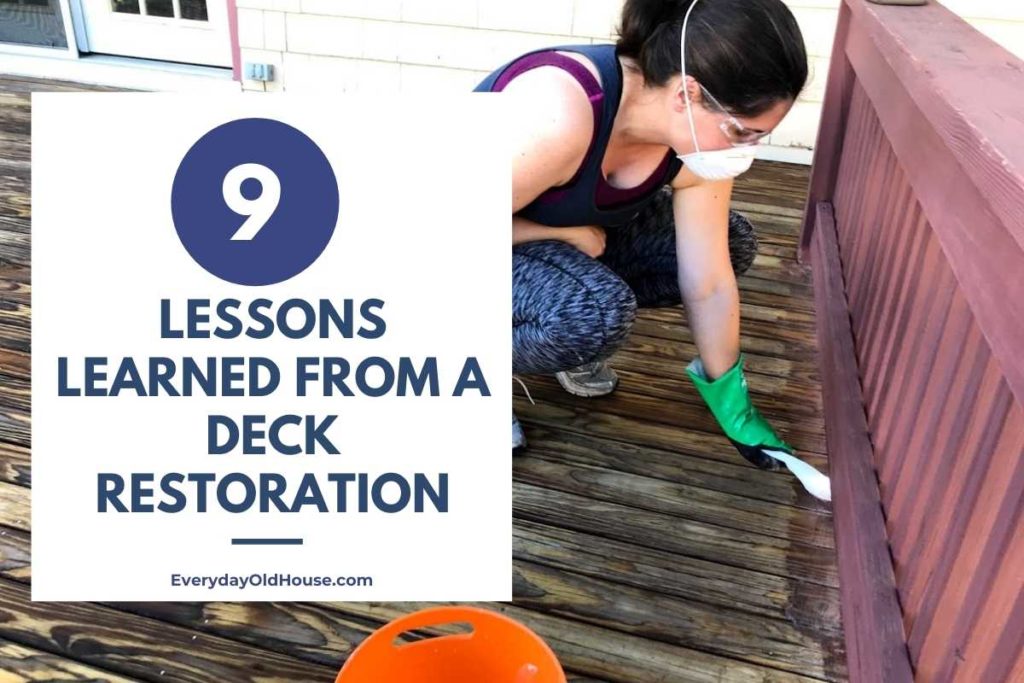Last Updated on January 4, 2024
Eucalyptus wood is an ideal choice for outdoor patio furniture based on its natural ability to repel water, its sustainable harvesting practices and affordable price. However, like all wood furniture, it requires maintenance to look its best over the years. And that includes oiling the wood to create a waterproof barrier that stops the wood from drying out plus restoring that gorgeous rich wood color. But which oil should you use? This summer I tested two different oils – teak oil and linseed oil on eucalyptus patio furniture – to see which worked best. Here’s what I found….
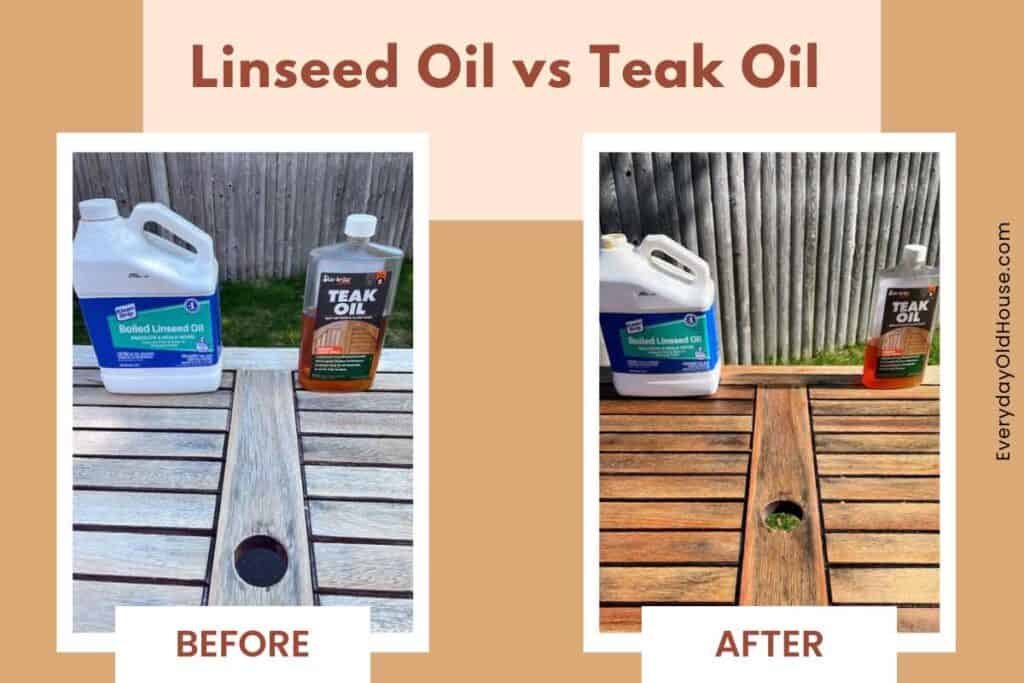
This post contains affiliate links, including but not limited to, Amazon Associates. As such, I earn from qualifying purchases. Full disclosure located here.
Backstory
A few years ago, we bought our first piece of wood patio furniture – a eucalyptus wood table. We experienced a horrible accident with our tempered glass patio table (luckily no one was hurt) so we were ready to replace it with a different material we deemed safer around children.
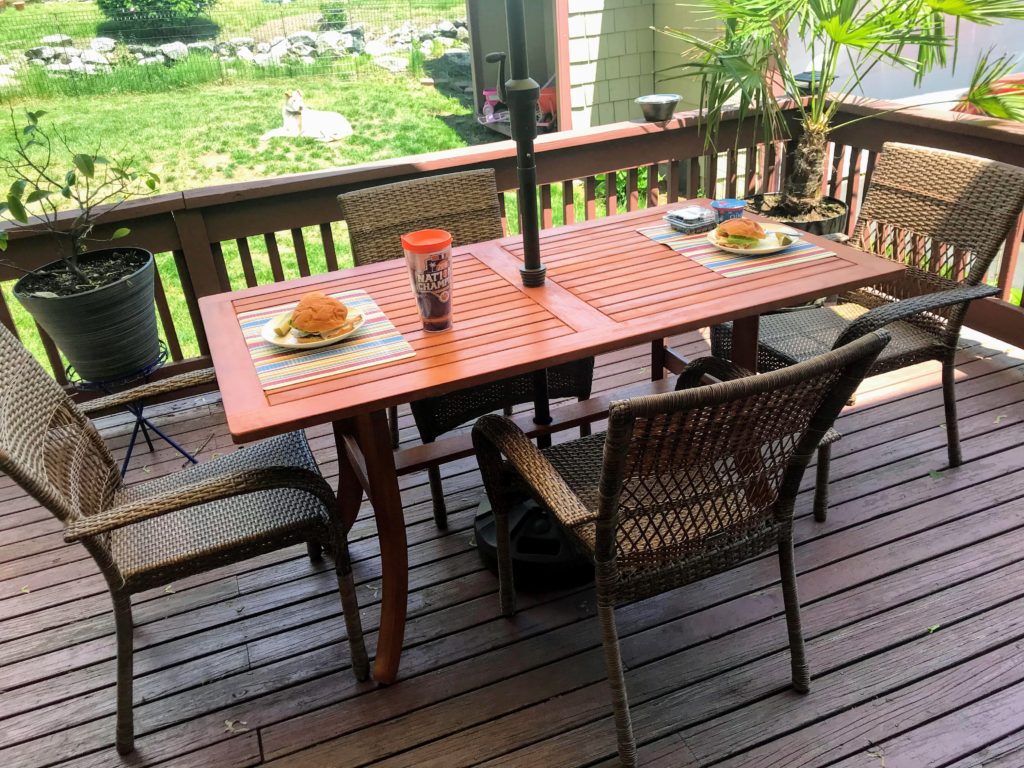
Since this was our first piece of outdoor eucalyptus furniture, I wasn’t aware of its need for treatment. We did nothing to the table – merely placed it out on the back desk for the summer, then stored over the winter in the garage. The following spring, when we pulled the table out of the garage, I was surprised at how weathered and grey the wood looked after only one summer.

Apparently (depending on your climate), you must treat outdoor eucalyptus furniture 1-2 times a year.
Whoops.
But NO biggie. Lesson learned. It was easy to restore our table with a teak cleaner, brightener and oil. And I’ve done that for the last few years.
Fast forward to this spring.
As I was pulling the patio table out from the garage, I noticed a bottle of linseed oil. Last summer my husband built raised vegetable garden beds and had used the linseed oil to treat the wood.
I’ve never used linseed oil before. It got me thinking… They are both wood finishing and protecting oils. How does it compare to teak oil? Should I put both on the patio table and see which one works best?
Hmmm…
OK – I’m getting ahead of myself. Let’s start with some basics before I dive into the actual comparison test.
Pros of Eucalyptus Patio Furniture
Eucalyptus is an incredibly strong hardwood with a several characteristics that make it perfect for patio and deck furniture, such as:
- Rot-resistant (i.e. naturally repels water & moisture)
- Budget-friendly: similar look as teak, but less than half the price
- Lower maintenance (compared to other materials)
- Sustainable & renewable: Fast-growing trees and reportedly sustainably harvested
- Long lifespan: If properly maintained, will last 25 years
Cons of Eucalyptus Patio Furniture
However, there are a few cons associated with eucalyptus patio furniture, including:
- Fading/ greying
- Dries out (esp. in extreme cold)
- Warps with excessive moisture
- Insect infestation
Luckily, these disadvantages can be overcome with regular maintenance.
Maintenance of Eucalyptus Patio Furniture
Eucalyptus wood naturally possesses a protective oil that gives it the characteristics that make it ideal for patio furniture. However, over time these protective oils naturally evaporate. It’s unavoidable and leaves the wood susceptible to cracks and damage.
The most effective way to slow down the aging process is to treat the eucalyptus wood on a regular basis with a deep penetrating wood finishing oil. In other words, “feeding” the wood with a deep-penetrating oil that achieves 2 goals:
- Creates a waterproof barrier that repels water and moisture (preventing cracks and warps) and
- Restores the wood’s warm, rich color and accentuates the wood grain.
What to Look For in Oil for Eucalytpus
There are a variety of wood protecting oils on the market. Here’s what you should look for in a protecting oil for eucalyptus wood:
- Water resistant (i.e. OK for outdoor use)
- Deep penetrating
- Easy to apply (rub on, rub off)
- Flexible (i.e., stays intact as wood expands and contracts)
- Accentuates wood texture and grain
Personally, I’ve been applying teak oil every year. Specifically the Star Brite brand Teak Oil. But this year I decided to test that teak oil against linseed oil.
What is Linseed Oil?
Linseed oil an extract of flax seed that protects natural wood from decaying. Linseed oil is sold in two forms – raw or boiled.
Raw linseed oil is a pure form without any chemicals or additives. Perfect solution wood finishing oil for folks sensitive to introducing chemicals in their homes. However, raw linseed oil takes a LONG time to cure. Like a lot. It can take days or even weeks to thoroughly dry.
Personally, I want to use my patio table ASAP when the weather warms up. Boiled linseed oil solves the problem of long dry times. It dries a lot faster than raw linseed oil. However, it dries faster because it contains various drying agents, stabilizers and hardeners (aka chemicals).
What is Teak Oil?
Unlike linseed oil, which comes from, well, linseeds, teak oil is not derived from teak trees. Instead, it is commonly a blend of other oils, including tung oil, linseed oil and mineral oil, with petroleum-based solvents and varnishes for increased effectiveness.
Before this post, I never thought about what teak oil really was. I assumed it was oil extracted from teak trees. (Go ahead and call my naïve, it’s okay. I’m a newbie DIYer and learn as I go).
I never thought to look at the ingredient deck for the Star brite teak oil. The label on the back of the bottle provided limited information on ingredients, but I was able to find the California Cleaning Product Disclosure, which listed TUNG oil.
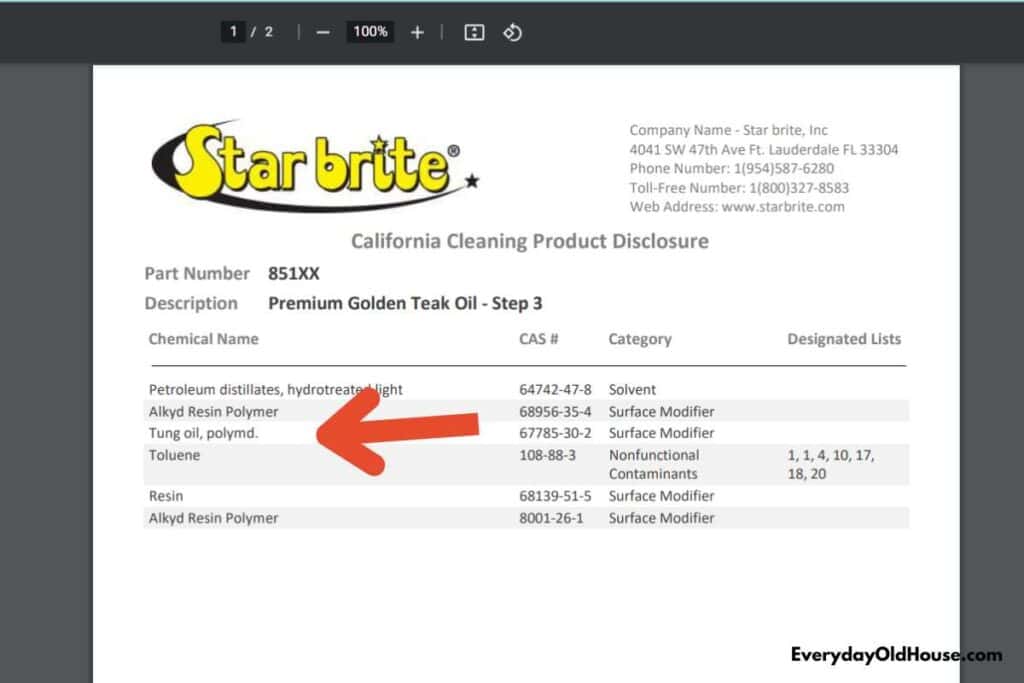
Huh. So….perhaps this post should be better entitled – tung oil versus linseed oil on eucalyptus patio furniture?
Note that teak oil is considered a blend of oil, so teak oil made by one company will be different from another. If you decide to use teak oil, make sure you research to understand the blend of oils.
What is Tung Oil?
Tung oil is made from pressing seeds from the nuts of a tung tree, which is mostly grown in China. In fact the tung gets its name for its heart-shaped leaves because “tung” is Chinese for “heart.”
Pur tung oil has many similarities to raw linseed oil. For example, it contains no chemicals, consisdered non-toxic and food-safe. It also has a very slow drying time – but tung oil drying time is only 2-3 days versus linseed oil’s several weeks. One of the cons of tung oil is its price – it is usually much more expensive than raw linseed oil.
Teak vs Linseed Oil on Eucalyptus Patio Furniture
As I mentioned before, every year I quickly sand, clean, and treat the tabletop of my eucalyptus patio table. You can find detailed instructions here.
[Note: I don’t sand the legs and underneath the tabletop. It still has the original reddish hue because it’s more protected from the elements. I merely clean, brighten and treat with teak oil.]
This year I followed the same method of sanding and cleaning with the Star brite teak cleaner and brightener. But this year I decided to oil ½ of the table with Star brite teak oil and the other ½ with Kleen Strip boiled linseed oil.
Here’s the before photo.
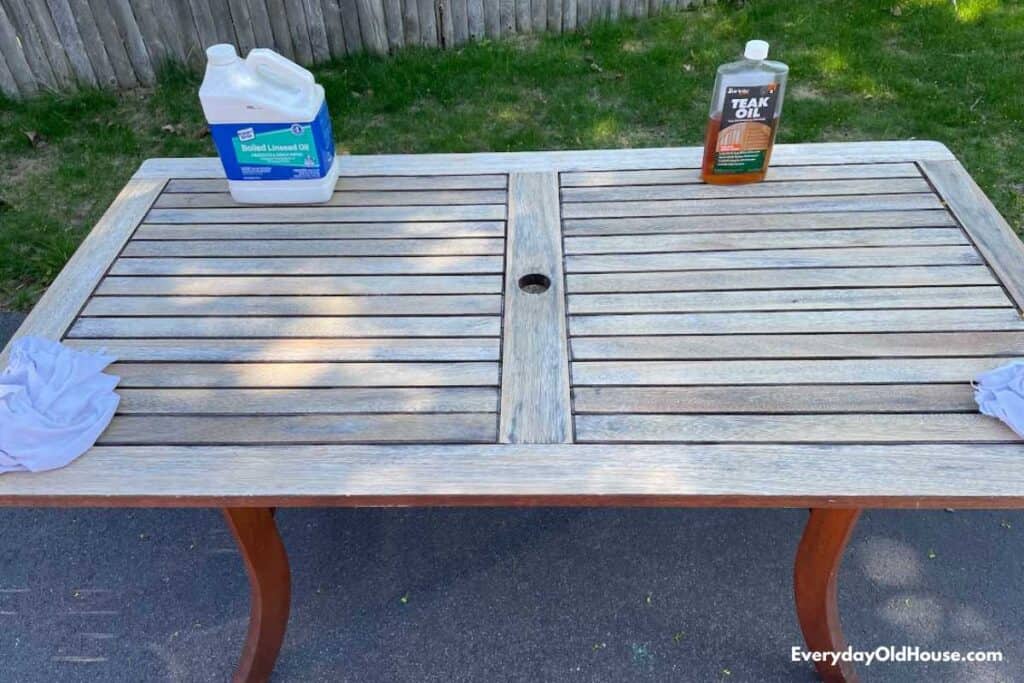
Before and…. After…
Well, I’ll let you look and decide for yourself!
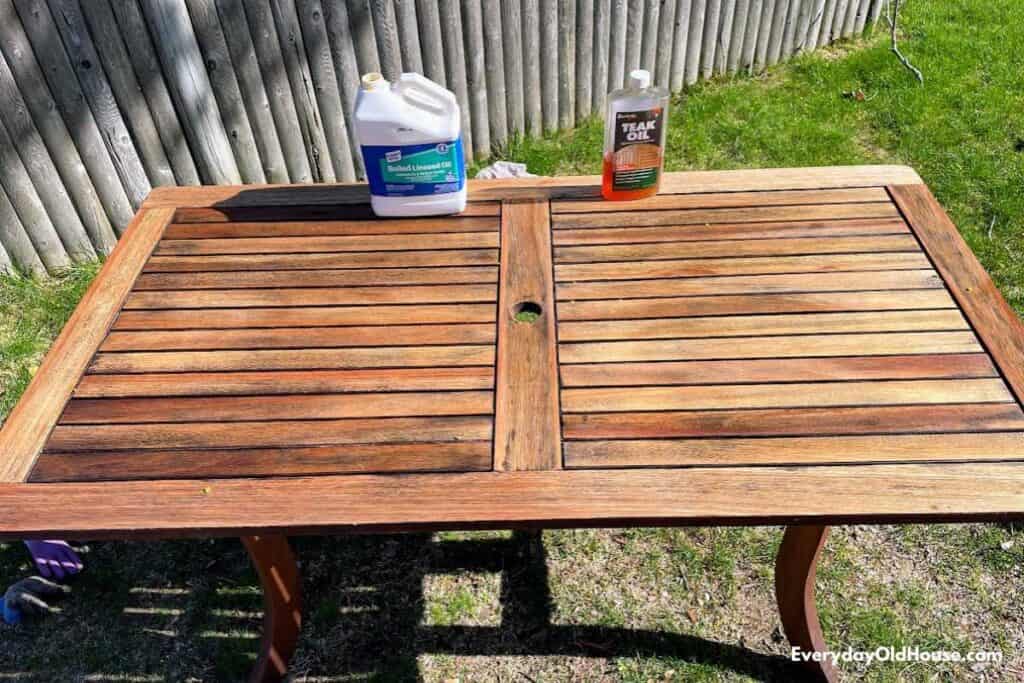
Looks somewhat similar, eh? But I do think the boiled linseed oil on eucalyptus patio furniture creates a slightly richer wood color, which I prefer. Considering that staining eucalyptus is difficult (due to the tight weave of the lumber’s fibers), I appreciate the color that can be restored.
I’m curious to see how the table will look after a harsh season in the sun. I’ll keep you posted….
Safety Concern with Linseed Oil
There is one significant safety issue with linseed oil that may persuade me to stick with the Star brite teak oil even if the linseed oil side of the table produces a richer hue.
Potential spontaneous combustion of used cloths.
Yup.
Like Danish oil, linseed oil generates heat when it dries. Therefore, it is IMPERATIVE that any cloth with linseed oil is immediately rinsed thoroughly with water and detergent, and then spread outside to dry in a cool, dry space for at least 24-48 hours.
Admittedly, I didn’t completely rinse out my rags. And shame on me. I draped the half-rinsed cloth over my garbage bin to dry and I found it AND the garbage bin VERY warm to the touch a few hours later.
It served as a good warning to take working with linseed oil more seriously.
Other Option to Protect Eucalyptus Furniture?
In researching this post, I came across another option to protect eucalyptus furniture – teak sealers.
Apparently, teak sealers differ from teak oils. Instead of “feeding” the wood oil, it seals in the existing oil already in the wood.
While I like this idea, I won’t consider testing the effectiveness of oils versus sealants. My patio table is a few years old and I believe that a significant portion of natural oils have already evaporated. BUT if I was buying new eucalyptus patio furniture, I would consider applying a sealer in the first year.
Related Posts
Want to be the first to know about new posts? Be sure to follow me on Pinterest, Facebook, Instagram or Twitter of even Etsy! Or better yet… Subscribe below!
My monthly (admittedly sometimes more, sometimes less….) emails are like receiving a unexpected letter from an old friend WITHOUT needing to put on your slippers and walk out to your mailbox…. See? I got ya, my friend!)
[Note: My posts are proudly connected to these amazing link parties full of DIY ideas and inspiration!]





